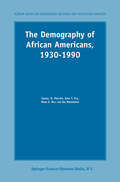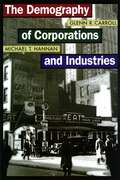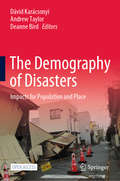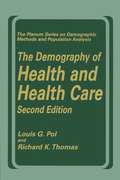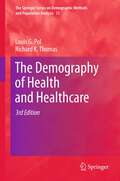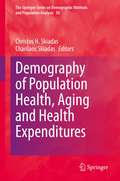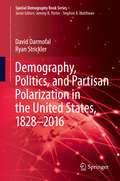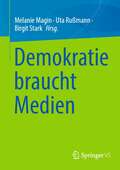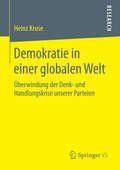- Table View
- List View
The Demography of African Americans 1930–1990 (The Springer Series on Demographic Methods and Population Analysis)
by S.H. Preston I.T. Elo Mark E. Hill Ira RosenwaikeThe authors of this work use a novel strategy that combines record linkage and demographic/statistical analysis to produce an internally consistent and robust set of estimates of the African-American population during the period 1930-1990. They interpret the record that emerges, with special reference to longevity trends and differentials. This work is for demographers, sociologists and students of ethnic studies.
The Demography of Armed Conflict (International Studies in Population #5)
by Helge Brunborg Ewa Tabeau Henrik UrdalThe Demography of Corporations and Industries
by Glenn R. Carroll Michael T. HannanMost analysts of corporations and industries adopt the focal perspective of a single prototypical organization. Many analysts also study corporations primarily in terms of their internal organizational structures or as complex systems of financial contracts. Glenn Carroll and Michael Hannan bring fresh insight to our understanding of corporations and the industries they comprise by looking beyond prototypical structures to focus on the range and diversity of organizations in their social and economic setting. The result is a rich rendering of analysis that portrays whole populations and communities of corporations. The Demography of Corporations and Industries is the first book to present the demographic approach to organizational studies in its entirety. It examines the theory, models, methods, and data used in corporate demographic research. Carroll and Hannan explore the processes by which corporate populations change over time, including organizational founding, growth, decline, structural transformation, and mortality. They review and synthesize the major theoretical mechanisms of corporate demography, ranging from aging and size dependence to population segregation and density dependence. The book also explores some selected implications of corporate demography for public policy, including employment and regulation. In this path-breaking book, Carroll and Hannan demonstrate why demographic research on corporations is important; describe how to conduct demographic research; specify fruitful areas of future research; and suggest how the demographic perspective can enrich the public discussion of issues surrounding the corporation in our constantly evolving industrial society. All researchers and analysts with an interest in this topic will find The Demography of Corporations and Industries an invaluable resource.
The Demography of Corporations and Industries (PDF)
by Glenn R. Carroll Michael T. HannanMost analysts of corporations and industries adopt the focal perspective of a single prototypical organization. Many analysts also study corporations primarily in terms of their internal organizational structures or as complex systems of financial contracts. Glenn Carroll and Michael Hannan bring fresh insight to our understanding of corporations and the industries they comprise by looking beyond prototypical structures to focus on the range and diversity of organizations in their social and economic setting. The result is a rich rendering of analysis that portrays whole populations and communities of corporations. The Demography of Corporations and Industries is the first book to present the demographic approach to organizational studies in its entirety. It examines the theory, models, methods, and data used in corporate demographic research. Carroll and Hannan explore the processes by which corporate populations change over time, including organizational founding, growth, decline, structural transformation, and mortality. They review and synthesize the major theoretical mechanisms of corporate demography, ranging from aging and size dependence to population segregation and density dependence. The book also explores some selected implications of corporate demography for public policy, including employment and regulation. In this path-breaking book, Carroll and Hannan demonstrate why demographic research on corporations is important; describe how to conduct demographic research; specify fruitful areas of future research; and suggest how the demographic perspective can enrich the public discussion of issues surrounding the corporation in our constantly evolving industrial society. All researchers and analysts with an interest in this topic will find The Demography of Corporations and Industries an invaluable resource.
The Demography of Disasters: Impacts for Population and Place
by Dávid Karácsonyi Andrew Taylor Deanne BirdThis open access book provides worldwide examples demonstrating the importance of the interplay between demography and disasters in regions and spatially. It marks an advance in practical and theoretical insights for understanding the role of demography in planning for and mitigating impacts from disasters in developed nations. Both slow onset (like the of loss polar ice from climate change) and sudden disasters (such as cyclones and man-made disasters) have the capacity to fundamentally change the profiles of populations at local and regional levels. Impacts vary according to the type, rapidity and magnitude of the disaster, but also according to the pre-existing population profile and its relationships to the economy and society. In all cases, the key to understanding impacts and avoiding them in the future is to understand the relationships between disasters and population change. In most chapters in this book we compare and contrast studies from at least two cases and summarize their practical and theoretical lessons.
The Demography of Europe
by Gerda Neyer, Gunnar Andersson, Hill Kulu, Laura Bernardi and Christoph BühlerOver the past decades Europe has witnessed fundamental changes of its population dynamics and population structure. Fertility has fallen below replacement level in almost all European countries, while childbearing behavior and family formation have become more diverse. Life expectancy has increased in Western Europe for both females and males, but has been declining for men in some Eastern European countries. Immigration from non-European countries has increased substantially, as has mobility within Europe. These changes pose major challenges to population studies, as conventional theoretical assumptions regarding demographic behavior and demographic development seem unfit to provide convincing explanations of the recent demographic changes. This book, derived from the symposium on “The Demography of Europe” held at the Max Planck Institute for Demographic Research in Rostock, Germany in November 2007 in honor of Professor Jan M. Hoem, brings together leading population researchers in the area of fertility, family, migration, life-expectancy, and mortality. The contributions present key issues of the new demography of Europe and discuss key research advances to understand the continent’s demographic development at the turn of the 21st century.
The Demography of Health and Health Care (The Springer Series on Demographic Methods and Population Analysis)
by Louis G. Pol Richard K. ThomasThis is a thoroughgoing revision of the first edition of this classic text and reference, published by Plenum in 1992. The authors convey the general principles that underlie this applied subdiscipline and demonstrate how the merging of demography and health care impacts on the planning processes of a range of health care organizations.
The Demography of Health and Healthcare (The Springer Series on Demographic Methods and Population Analysis #13)
by Louis G. Pol Richard K. ThomasIn this 3rd edition of the definitive work on health demography, Pol and Thomas offer an updated view of the field and a current perspective on the applications of health demography to contemporary issues. The significance of health demography within the field of population studies has continued to increase and this work provides background on the healthcare arena and systematically presents the various aspects of demography as they relate to healthcare. This addition has been streamlined to focus on the important aspects of health demography and enhanced through the addition of charts, maps and other graphics. All statistics and tables have been updated and the most current references are included. A separate chapter on morbidity has been included and the final chapter focuses on the public policy interface with health demography. Case studies and sidebars are included throughout the book to illustrate the applications of demography within the healthcare arena. Recent developments in U.S. healthcare are highlighted to give the text a very contemporary presence.
Demography of Population Health, Aging and Health Expenditures (The Springer Series on Demographic Methods and Population Analysis #50)
by Christos H. Skiadas Charilaos SkiadasThis book provides theoretical and applied material for estimating vital parts of demography and health issues including the healthy aging process along with calculating the healthy life years lost to disability. It further includes the appropriate methodology for the optimum health expenditure allocation. Through providing data analysis, statistical and stochastic methodology, probability approach and important applications, the book explores topics such as aging and mortality, birth-death processes, self-perceived age, life-time and survival as well as pension and labor-force. By providing a methodological approach to health problems in demography and society including and quantifying important parameters, this book is a valuable guide for researchers, theoreticians and practitioners from various disciplines.
Demography of Refugee and Forced Migration (International Studies in Population #13)
by Graeme Hugo Mohammad Jalal Abbasi-Shavazi Ellen Percy KralyThis authoritative and comprehensive edited volume presents current research on how demography can contribute to generating scientific knowledge and evidence concerning refugees and forced migration, developing evidence based policy recommendations on protection for forced migrants and reception of refugees, and revealing the determinants and consequences of migration for origin and destination regions and communities. Refugee and other forced migrations have increased substantially in scale, complexity and diversity in recent decades. These changes challenge traditional approaches in response to refugee and other forced migration situations, and protection of refugees. Demography has an important contribution to make in this analytic space. While other disciplines (especially anthropology, law, geography, political science and international relations) have made major contributions to refugee and forced migration studies, demography has been less present with most research focusing on issues of refugee mortality and morbidity. This book specifies the range of topics for which a demographic approach is highly appropriate, and identifies findings of demographic research which can contribute to ever more effective policy making in this important arena of human welfare and international policy.
The Demography of Remarriage in Japan (SpringerBriefs in Population Studies)
by James M. Raymo Miho Iwasawa Erika Teramoto Shohei Yoda Setsuya FukudaThis book provides the first comprehensive demographic overview of remarriage in Japan. Despite the fact that nearly one in five marriages in Japan now involves at least one formerly married spouse, very little is known about the nature of remarriages and how they differ from first marriages. One important focus of this book is to examine fertility intentions and outcomes in remarriages and to compare them with marriages in which both partners are in their first marriage. It is well known that low rates of first marriage contribute to Japan’s very low total fertility rate (TFR), but there is currently no theoretical or empirical basis for understanding how levels and patterns of remarriage are related to the TFR. To understand trends and patterns of remarriage in Japan, the book begins with an overview of the voluminous research literature on remarriage in the USA and other Western countries. This overview consists of a summary of trends and theoretical frameworks for understanding remarriage and is followed by a summary of existing research on correlates of remarriage and outcomes associated with higher-order marriages. Of particular importance is the attention paid to stepfamily fertility and the extent to which remarriage is associated with overall levels of fertility. An important contribution of this book is its presentation of basic descriptive information about levels and correlates of remarriage in Japan. These descriptive analyses are based on published data in the vital statistics reports and individual-level data from the National Fertility Surveys conducted by the National Institute of Population and Social Security Research and the National Survey of Households with Children conducted by the Japan Institute for Labour Policy and Training.
Demography of Russia: From the Past to the Present (Studies in Economic Transition)
by Tatiana Karabchuk Kazuhiro Kumo Ekaterina SeleznevaThis book examines the demographic development of Russia from the late Russian Empire to the contemporary Russian Federation, and includes discussions of marriage patterns, fertility, mortality, and inter-regional migration. In this pioneering study, the authors present the first English-language overview of demographic data collection in Russia. Chapters in the book offer a systematic overview of the legislation regulating fertility and the family sphere, a study of the factors determining first and higher order births, and an examination of population distribution across Russian regions. The book also combines research tools from the social sciences with a medical approach to provide a study of mortality rates. By bringing together approaches from several disciplines – demography, economics, and sociology – the authors of this book provide a comprehensive and detailed assessment of the historical roots of Russia's demographic development.
The Demography of Transforming Families (The Springer Series on Demographic Methods and Population Analysis #56)
by Robert SchoenThis book provides an up-to-date survey on the nature, causes, and patterns of family change. The traditional nuclear family has been replaced by a multiplicity of other forms, as widespread cohabitation, high levels of divorce and union dissolution, rising childlessness, and far below replacement fertility have emerged to an extent never before seen. Theoretical perspectives on this “Second Demographic Transition” are presented, highlighting the dramatic changes in gender roles. New methodological strategies for assessing family dynamics are presented, from multistate models of marriage and divorce combined with fertility to improved techniques for combining census and survey data on the family to a new approach for disentangling age, period, and cohort effects. While the volume emphasizes Western nations, insightful case studies range from analyzing family complexity in cohorts of parents and children in the UK to the impact of interpartner violence on family formation, to the emergence of a “gender war” in South Korea. By providing new insights into where we are today and how we got here, the book will be of value to all those interested in the contemporary family."Delayed Fertility as a Driver of Fertility Decline?" available open access under a Creative Commons Attribution 4.0 International License via link.springer.com.
Demography of Transgender, Nonbinary and Gender Minority Populations
by Amanda K. Baumle Sonny NordmarkenThis book provides the first compilation of demographic research focused on transgender, nonbinary, and gender minority populations. It discusses the measurement and conceptualization challenges that shape demographic knowledge of these populations, including how we capture gender on surveys. It examines our current knowledge of demographic characteristics and health disparities and outcomes. Overall, this research demonstrates the increasing knowledge of gender variation at the population level. At the same time, it reveals the need for better survey questions, additional data, and inquiry into a broader subset of demographic questions for these populations as there is little understanding of fundamental demographic information, including migration or spatial distribution of transgender populations, fertility and household structure, labor market outcomes, or broader patterns of morbidity and mortality. The research set forth in this book lays the groundwork for a trans demography that would produce population-level knowledge of these populations and points researchers and policymakers toward needed areas of research, conceptualization, and data collection.
Demography of Tropical Africa (PDF)
by William BrassThis treatise on the demography of sub-Saharan Africa contains materials on age and sex composition, fertility, and mortality. Sets of demographic data are emerging that provide the completeness and specificity required for critical evaluation and analysis. The main body of the work consists of case studies on the Republic of the Congo, French-speaking territories, Portuguese territories, the Sudan, and Nigeria. Evidence is described in critical detail, methods of analysis are presented in full; and the reader is given the basis for judging the quality of the estimates.Originally published in 1968.The Princeton Legacy Library uses the latest print-on-demand technology to again make available previously out-of-print books from the distinguished backlist of Princeton University Press. These editions preserve the original texts of these important books while presenting them in durable paperback and hardcover editions. The goal of the Princeton Legacy Library is to vastly increase access to the rich scholarly heritage found in the thousands of books published by Princeton University Press since its founding in 1905.
Demography, Politics, and Partisan Polarization in the United States, 1828–2016 (Spatial Demography Book Series #2)
by David Darmofal Ryan StricklerThis book examines the geography of partisan polarization, or the Reds and Blues, of the political landscape in the United States. It places the current schism between Democrats and Republicans within a historical context and presents a theoretical framework that offers unique insights into the American electorate. The authors focus on the demographic and political causes of polarization at the local level across space and time. This is accomplished with the aid of a comprehensive dataset that includes the presidential election results for every county in the continental United States, from the advent of Jacksonian democracy in 1828 to the 2016 election. In addition, coverage applies spatial diagnostics, spatial lag models and spatial error models to determine why contemporary and historical elections in the United States have exhibited their familiar, but heretofore unexplained, political geography. Both popular observers and scholars alike have expressed concern that citizens are becoming increasingly polarized and, as a consequence, that democratic governance is beginning to break down. This book argues that once current levels of polarization are placed within a historical context, the future does not look quite so bleak. Overall, readers will discover that partisan division is a dynamic process in large part due to the complex interplay between changing demographics and changing politics.
Demography: A Very Short Introduction (Very Short Introductions)
by Sarah HarperThe generation into which each person is born, the demographic composition of that cohort, and its relation to those born at the same time in other places influences not only a person's life chances, but also the economic and political structures within which that life is lived; the person's access to social and natural resources (food, water, education, jobs, sexual partners); and even the length of that person's life. Demography, literally the study of people, addresses the size, distribution, composition, and density of populations, and considers the impact the drivers which mediate these will have on both individual lives and the changing structure of human populations. This Very Short Introduction considers the way in which the global population has evolved over time and space. Sarah Harper discusses the theorists, theories, and methods involved in studying population trends and movements, before looking at the emergence of new demographic sub-disciplines and addressing some of the future population challenges of the 21st century. ABOUT THE SERIES: The Very Short Introductions series from Oxford University Press contains hundreds of titles in almost every subject area. These pocket-sized books are the perfect way to get ahead in a new subject quickly. Our expert authors combine facts, analysis, perspective, new ideas, and enthusiasm to make interesting and challenging topics highly readable.
Demokratie — eine Kultur des Westens?: 20. Wissenschaftlicher Kongreß der Deutschen Vereinigung für Politische Wissenschaft
by Michael Th. GrevenIn einer Zeit, in der weltweit sozialer Wandel als radikal beschleunigt wahrgenommen wird, erschien lange Zeit allein die westliche Demokratie als normatives und institutio nelles Unterpfand der Stabilität. Mit ihr schien in den rund zweihundert Jahren ihrer Geschichte die politische Form gefunden, in der sozialer Wandel besonders erfolgreich politisch verarbeitet werden könnte. Ihre weltweite Ausbreitung und faktische Univer salisierung schien in diesem beschleunigten Wandel nur eine Frage der Zeit zu sein. Nach der Implosion des sowjetischen Herrschaftsmodells wirkten die verbliebenen un demokratischen Regime nur noch wie vormoderne Relikte, die Idee alternativer und weltweit konkurrierender Entwicklungsmodelle politischer Gesellschaften verblaßte. Drei Entwicklungen haben diese Selbstgewißheit in Politik und Politikwissenschaft in den letzten Jahren verunsichert. China, einige islamische Gesellschaften und andere kleinere Staaten machen keine Anstalten, die westliche Demokratie zu übernehmen. Vielmehr proklamieren sie in mehr oder weniger starker Auseinandersetzung mit westlichen Vorstellungen "eigene Wege" mit anderen normativen Prioritäten und anderen kulturellen Grundlagen. In den westlichen Demokratien wächst das Bewußtsein, daß in dem alle anderen gesellschaftlichen Bereiche umkrempelnden schnellen sozialen Wandel eine Dynamik enthalten sei, die auch die bisher als stabil und "endgültig" gedachten Institutionen der westlichen Demokratien erfassen könnte.
Demokratie als Herrschaftsordnung (Ordo Politicus #7)
by Manfred HättichDemokratie als Thema der Wissenschaften ist so umfassend und vielschichtig, daß vor weg eine Verständigung über die begrenzte Absicht notwendig ist. Im Grunde dient die Abhandlung der Begründung einer einzigen These: daß eine Ordnungsvorstellung nützlich und möglich ist, die weder positiv-staatsrechtlicher noch sozialphilosophischer Natur, aber auf beide Verfahren hin offen ist; die nicht historisch gebunden, aber den von den Zeitgenossen vollziehbaren allgemeinsten demokratischen Ideengehalten zu mindest nicht konträr ist. Mit dem Demokratiebegriff wird der Versuch einer eigenen, auf fundamental vor gegebenen Sozialphänomenen aufgebauten politischen Ordnungstheorie zur Diskussion gestellt. Doch hätten wir vom augenblicklichen Stand unserer Einsicht aus keine grund sätzlichen Einwendungen zu machen, würde man unser Vorgehen der politischen Sozio logie zurechnen; würde eine uns so in Anspruch nehmende Soziologie doch den hier für erkenntnisfördernd gehaltenen hohen Abstraktionsgrad akzeptieren, eine Abstrak tion, die sich von jeder empirischen und historischen Individualisierung weit entfernt hat, ohne schon in die philosophische Reflexion zu münden. In diesem Abstraktionsgrad sehen wir die Rechtfertigung unserer Arbeit. Unbeschadet etlicher »weißer Flecken« ist die detaillierte Demokratieforschung eine reichhaltige; wir haben darin kaum Neues zu bieten, sondern viel vorauszusetzen. Umgekehrt wird jede Systematik Aufforderungen zu Einzelforschungen enthalten, da sie auch von ihr selbst nicht beantwortete Fragen in Erinnerung bringt. Jeder systematische Versuch ist, weil Denken Bewegung und nicht Fertigung ist, ein sich noch zu bewährender Entwurf. Wir verstehen deshalb unsere These eher als Programm denn als Ergebnis, was unse rer derzeitigen Überzeugung von ihrer Richtigkeit keinen Abbruch tut.
Demokratie als Lebensform: Die Welt in der Krise des Kapitalismus (Gesammelte Schriften #11)
by Günter DuxDemokratie ist nur unzureichend verstanden, wenn sie im öffentlichen Bewusstsein wie in der Wissenschaft als eine Verfassungsform verstanden wird, in der die politische Meinungs- und Willensbildung für jeden offen ist. Gewiss, doch im Fluchtpunkt der Offenheit der formalen Verfasstheit der Demokratie liegt ihre materiale Zielvorgabe: Demokratie, ist die Verfassungsform, die dazu bestimmt ist, allererst die gesellschaftlichen Bedingungen einer selbstbestimmten Lebensführung des Subjekts zu schaffen. Der InhaltWorum es geht. Demokratie als LebensformZeitenwende. Die humane Lebensform in einer sӓkular gewordenen WeltDie selbstbestimmte Lebensform als von Sinn bestimmte LebensformDie Wahrheit der Demokratie. Die zwei DemokratienDer dreifache Wahrheitssatz der DemokratieDie humane Lebensform unter der Machtverfassung der Gesellschaft. Der Verlust der SelbstbestimmungDie athenische DemokratieDie Genese der Demokratie als bürgerliche DemokratieDie Demokratie einer kapitalistisch verfassten Marktgesellschaft. Der Widerstreit mit dem ökonomischen SystemDie soziale Demokratie Lorenz von SteinsDie Ausbildung der formalen Demokratie. Die Hoffnung des ProletariatsDemokratie und Sozialstaat. Der Sozialstaat des VerschwindensDie Aufkündigung der Idee der Demokratie. Das Subjekt als Unternehmer seiner ArbeitskraftDie Krise der Marktgesellschaft als Krise der DemokratieDie europӓische Wӓhrungskrise als Krise von Demokratie und GesellschaftEine andere Demokratie in einer anderen GesellschaftZum Schluss. Ortsbestimmung der GegenwartAnhang: Die Theorie der deliberativen Demokratie Jürgen Habermas'Der AutorDr. Günter Dux ist Prof. emeritus am Institut für Soziologie der Albert-Ludwigs-Universität Freiburg.
Demokratie auf dem Prüfstand: Bürger, Staaten, Weltwirtschaft
by Ulrich WillemsAutoren aus Politik, Publizistik und Wissenschaft erwägen Möglichkeiten und Probleme einer plebiszitären Ergänzung der repräsentativen Demokratie sowie einer Demokratisierung des europäischen und internationalen Regierens.
Demokratie braucht Medien
by Melanie Magin Uta Rußmann Birgit StarkFreie und unabhängige Medien sind die Grundlage einer lebendigen Demokratie. In normativen Demokratiemodellen wird die „Wächterrolle“ von Medien betont, weil neben der Kontroll- und Informationsfunktion der Medien ihr Beitrag zur Legitimierung politischer Prozesse als zentral angesehen wird. Medien unterliegen jedoch im digitalen Wandel einem hohen Anpassungsdruck: Sie drohen ihre traditionelle Gatekeeper-Rolle zu verlieren und konkurrieren mit globalen Tech-Giganten wie Facebook und Google um Werbegelder und die Aufmerksamkeit des Publikums. Die Plattformisierung der Medien stellt nicht nur die Vermittlungsleistungen professioneller journalistischer Informationsanbieter in Frage, sondern auch die Rolle der Medien in der Herstellung von Öffentlichkeit. Der Band hinterfragt die sich wandelnde Rolle der Medien im politischen System sowie das Verhältnis von Medien und Politik kritisch. Funktionen und Autonomiegrad von Medien und Journalismus werden analysiert. Mithilfe von Zeitvergleichen werden tiefgreifende Veränderungen wie auch Konstanten herausgearbeitet. Nicht zuletzt gilt es zu erörtern, welche Akteure welche Verantwortung tragen und welche Privilegien sie genießen (sollten).
Demokratie entwickelt Schule: Schulentwicklung auf der Basis des Denkens von John Dewey
by Martin RetzlSchulentwicklung wird oft als ein diffus definiertes Feld wahrgenommen, dem es an theoretischer Fundierung mangelt. Martin Retzl fundiert unter Rückgriff auf John Dewey ein Schulentwicklungsmodell und beschreibt dessen Durchführung. Er zeigt, dass innerhalb des Dewey‘schen Denkens eine Theorie intentionaler sozialer Entwicklung enthalten ist, aus der konkrete Prinzipien extrahiert werden können, welche empirisch anwendbar und somit leitend für Schulentwicklung sein können. Diese Prinzipien sind insbesondere aus den Dewey‘schen Konzepten des demokratischen Ideals und der social inquiry ableitbar und werden als Grundlage für ein Schulentwicklungsmodell angesehen, das im Zuge der Evaluation eines Schulversuchs erprobt werden konnte. Die Dokumentation der Durchführung an zwei nach Lage und sozioökonomischen Hintergrundbedingungen sehr unterschiedlichen Schulen in Niederösterreich zeigt, dass sich die Prinzipien intentionaler sozialer Entwicklung im Bereich Schule prinzipiell als anwendbar erweisen.
Demokratie in einer globalen Welt: Überwindung der Denk- und Handlungskrise unserer Parteien
by Heinz KruseSteckt unsere Demokratie in einer Krise? Fühlt sich die Politik nicht mehr an das allgemeine Wohl als ihr oberstes Ziel gebunden? Die wechselseitige Entfremdung zwischen Bürgerschaft und politischen Akteuren sollte in einer funktionierenden Demokratie ausgeschlossen sein. Dennoch hat sich scheinbar eine solche Entfremdung eingeschlichen – demokratische Strukturen sind nur noch eine Formalität zur Legitimation der existierenden Machtstrukturen. Parteieliten und Wirtschaftsmächtige scheinen gleichgeschaltete Interessen zu haben. Heinz Kruse kreist um die Frage, mit welchen Mitteln unsere Politik wieder demokratisiert werden könnte. Er wirft einen Blick auf die wirtschaftlichen und politischen Grundlagen einer modernen Demokratie. Der Autor zeigt auf, dass demokratische Reformen nötig und auch möglich sind, und skizziert einen Weg zur Umsetzung dieser Reformen.
